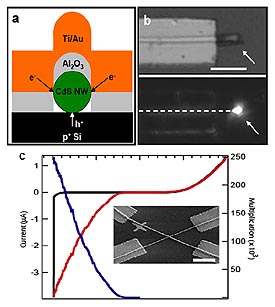Penn Engineers Design Electronic Computer Memory in Nanoscale Form That Retrieves Data 1,000 Times Faster
PHILADELPHIA -- Scientists from the University of Pennsylvania have developed nanowires capable of storing computer data for 100,000 years and retrieving that data a thousand times faster than existing portable memory devices such as Flash memory and micro-drives, all using less power and space than current memory technologies.
Tests showed extremely low power consumption for data encoding (0.7mW per bit). They also indicated the data writing, erasing and retrieval (50 nanoseconds) to be 1,000 times faster than conventional Flash memory and indicated the device would not lose data even after approximately 100,000 years of use, all with the potential to realize terabit-level nonvolatile memory device density.
"This new form of memory has the potential to revolutionize the way we share information, transfer data and even download entertainment as consumers," Agarwal said. "This represents a potential sea-change in the way we access and store data."
Phase-change memory in general features faster read/write, better durability and simpler construction compared with other memory technologies such as Flash. The challenge has been to reduce the size of phase change materials by conventional lithographic techniques without damaging their useful properties. Self-assembled phase-change nanowires, as created by Penn researchers, operate with less power and are easier to scale, providing a useful new strategy for ideal memory that provides efficient and durable control of memory several orders of magnitude greater than current technologies.
"The atomic scale of the nanodevices may represent the ultimate size limit in current-induced phase transition systems for non-volatile memory applications," Agarwal said.
Current solid-state technology for products like memory cards, digital cameras and personal data assistants traditionally utilize Flash memory, a non-volatile and durable computer memory that can be erased and reprogrammed electronically. Data on Flash drives provides most battery-powered devices with acceptable levels of durability and moderately fast data access. Yet the technology's limits are apparent. Digital cameras can't snap rapid-fire photos because it takes precious seconds to store the last photo to memory. If the memory device is fast, as in DRAM and SRAM used in computers, then it is volatile; if the plug on a desktop computer is pulled, all recent data entry is lost.
Therefore, a universal memory device is desired that can be scalable, fast, durable and nonvolatile, a difficult set of requirements which have now been demonstrated at Penn.
"Imagine being able to store hundreds of high-resolution movies in a small drive, downloading them and playing them without wasting time on data buffering, or imagine booting your laptop computer in a few seconds as you wouldn't need to transfer the operating system to active memory" Agarwal said.
The research was performed by Agarwal, Se-Ho Lee and Yeonwoong Jung of the Department of Materials Science and Engineering in the School of Engineering and Applied Science at Penn. The findings appear online in the journal Nature Nanotechnology and in the October print edition.
The research was supported by the Materials Research Science and Engineering Center at Penn, the University of Pennsylvania Research Foundation award and a grant from the National Science Foundation.
Contact: Jordan Reese jreese@pobox.upenn.edu 215-573-6604 University of Pennsylvania
Technorati Tags: Nano or Nanotechnology and Nanotech and University of Pennsylvania or computer data and memory devices or Do Androids Dream of Electric Sheep? and Halloween Graveyard (Safety Tips) and Look at nanotubes inside living animals VIDEO
















1 comment:
Interesting post. I've been looking into getting Cisco memory for my computer
Post a Comment